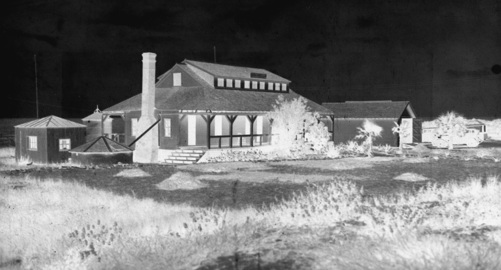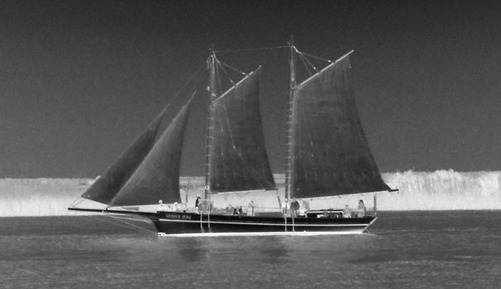The History of Florida (85 page)
Read The History of Florida Online
Authors: Michael Gannon
Tags: #History, #United States, #State & Local, #Americas

.
’s
e-
is
.
fm.
ida
i-
t of
ves
ida
ttp://
itage
x.c
y of
lor
ater
lor
ical R
, h
eam-
insville
w
ted with
tmen
or
t
Cit
reser
in
.flher
mission
te, Division
ist
ces
w
rchaeolog
epar
w
The st
boa
Hawk
one of F
Under
A
cal P
Repr
per
of the F
D
Sta
of H
sour
w
com/inde
proof
The Maritime Heritage of Florida · 405
twisted, jumbled pieces on the ocean bottom,
Lofthus
became an Underwa-
ter Archaeological Preserve in 2003. Similarly, the merchant ship
Catharine
wrecked in 1894 while attempting to enter Pensacola harbor to take on a
load of lumber.
Other lumber vessels were abandoned when they reached the end of
their useful life. In the Blackwater River, Shield’s Cove is a historic ship
graveyard. This maritime “junkyard” contains the sunken remains of ships
and boats that were no longer useful or profitable for their owners. Four
wooden-hulled lumber ships lie side by side where they were abandoned in
the 1930s.
Palafox,
George
T.
Locke,
Dinty
Moore,
and
Guanacastle
were all part of the northwest Florida lumber boom in the early twentieth century,
hauling cargoes of timber from the river towns of Milton and Bagdad to the
dockyards of Pensacola. Although not glamorous or famous, these work-
ing craft serve as reminders of the industry that helped to build northern
Florida.
Another key maritime industry, fishing, has long been associated with
Florida, from prehistoric peoples to the early modern era. The red snap-
per industry increased in the nineteenth century, as did the mul et and
pompano markets. Oysters also became a new market for Gulf coast towns,
which often relied on railroads to get shipments out quickly. By the 1890s,
proof
Florida was one of the top states engaged in commercial fisheries. Huge
fleets of fishing boats were based in the major harbors of Tampa, St. Au-
gustine, Apalachicola, Key West, and Pensacola. Many ports focused on
pursuing a particular species, and port towns became famous for their
signature catches, such as Apalachicola oysters, St. Augustine deep-water
shrimp, Tarpon Springs and Key West sponges, and Pensacola red snapper.
The ships and boats used in the industry were specialized for their tasks and
reflected the particular needs of the crews. For example, a vessel type called
a “smack” was used in the snapper fishing industry centered in the Gulf of
Mexico. Smacks developed from fishing boats native to New England that
were brought south to fish the offshore waters of the Gulf. These boats soon
were modified with a live well that circulated ocean water to keep the fish
alive during long voyages. The sound of the fish smacking against the hull is
credited with inspiring the unusual name.
Despite the large numbers of smacks built and used around the Florida
Gulf coast, no examples of the type remain afloat. A couple of wrecks, how-
ever, have been archaeological y investigated. A wooden-hul ed wreck in
the Blackwater River, appropriately called the Snapper Wreck, is an example
of a local y used smack. Although the vessel’s name is not known, it appears
406 · Del a A. Scott-Ireton and Amy M. Mitchell-Cook
to have been abandoned in the 1930s, when motor-driven fishing boats
proved more efficient than sailing craft. Another boat, cal ed Hamilton’s
Wreck for its discoverer, lies in shallow water on the west side of Pensacola
Bay. Probably wrecked during one of the hurricanes that struck Pensacola
in the early twentieth century, this vessel’s artifacts, along with construction
features, suggest the vessel was used in the local fishing industry.
The expansion of maritime industries in Florida, like lumbering and
fishing, relied on shipping and the necessary infrastructure to keep goods
flowing. Through the 1870s and 1890s, small sums of money went to river
and harbor improvement. For example, the Apalachicola River was opened
to Columbus, Georgia, as a means to promote traffic; however, the harbor
itself remained an issue. Dredging efforts at Cedar Key on the west coast
and the St. Johns River in the east, especial y around Jacksonville, helped
with waterborne commerce and state-wide transportation. By the 1880s,
Jacksonville alone had seventy-four vessels operating from its port. Despite
this improvement, however, Jacksonville, like other Florida ports, contin-
ued to face problems of shallow water, winding rivers, and shifting chan-
nels that limited the size and capabilities of watercraft. In response to these
problems, throughout the latter part of the nineteenth century, Jacksonville
implemented river and harbor improvements to make it a viable seaport;
proof
these improvements required continual maintenance wel into the twentieth
century.
Along with maritime improvements came advancements in other forms
of moving goods. Railroads, a major means of transportation by the last
decades of the nineteenth century, experienced a dramatic advance when in
1888 Standard Oil tycoon Henry Morrison Flagler began the railroad Flor-
ida East Coast System that descended the Atlantic coast from Jacksonville
to Miami in 1896, and to Key West in 1912. As a result of increased traffic of
people and goods, the port of Miami began much-needed harbor enhance-
ments. Various other internal rail lines connected Jacksonville, Pensacola,
and Tampa Bay to the rest of the United States. By 1900, the state had been
transformed from a few minor ports and rail heads servicing a small and
scattered population to a burgeoning network of modern harbors, steam
lines, and railroad systems that mirrored developments in New York and
New England.
While Florida focused on harbor and internal improvements, the United
States recognized an increased need for coastal defense and improved
marine safety. By the 1870s, the shoreline of Florida had several houses of
refuge, including those located at Malabar, Gilberts Bar, Indian River, and

The Maritime Heritage of Florida · 407
The Gilbert’s Bar house of refuge near Stuart in 1934. Courtesy of the U.S. Coast Guard.
Orange Grove. Often manned by a single keeper, the houses existed on
sparsely settled beaches and gave shelter to stranded or shipwrecked sailors.
A dramatic example of the need for such refuges occurred in 1904, when the
Italian barque
Georges
Valentine
wrecked on the east coast of Florida near
the town of Stuart. Loaded with a cargo of milled mahogany, the ship was
proof
en route from Pensacola to Buenos Aires, Argentina, when she was caught
in a powerful storm. Driven northward through the Straits of Florida, the
vessel ran aground on a shoal, causing her three iron masts to fall and the
hull to break apart; five of the crew were lost. Fortunately for the remainder,
the ship had wrecked near the Gilbert’s Bar house of refuge. Tired, cold, and
injured, the men struggled to the house to alert the keeper, Captain William
Rea, who provided aid, shelter, and food until the survivors could be sent
home to Italy. Seven of the twelve-man crew were saved, proving the worth
of the system of houses of refuge along Florida’s coasts. Today,
Georges
Val-
entine
is a Florida Underwater Archaeological Preserve and is listed on the
National Register of Historic Places.
Modern Maritime Florida: Great Depression, World Wars,
and Beyond
Into the twentieth century, Florida shipping solidified its place within
worldwide commerce. The First World War disrupted some of this inter-
national trade, but the war itself did not come to Florida waters. Instead,
the beginning of World War I brought about the birth of naval aviation at
408 · Del a A. Scott-Ireton and Amy M. Mitchell-Cook
Pensacola and, by 1919, seaplane, dirigible, and balloon pilots trained at the
base. After the war, Florida’s economy shifted to tourism and land sales. In
the 1920s, southern Florida became a major tourist destination. Big-game
fishing for marlin, tuna, and sailfish lured anglers to coastal towns including
Key West, Miami, Ft. Lauderdale, and Destin. Projects such as the Overseas
Highway boosted travel and tourism, and were a means to bring tourists to
the Florida Keys. During winter months, the population of southern Florida
expanded by 300 percent. Another project, first conceived in the late nine-
teenth century, the East Coast Canal (later renamed the Florida Intracoastal
Waterway) provided a protected inland waterway for trade and shipping,
but when opened, it proved to be more of a service to pleasure craft than a
route for merchant ships. However, such improvements did not go without
reverses. Col apsing land sales in 1926 and devastating hurricanes in 1926,
1928, and 1935 diminished growth, as did the Great Depression in 1929–40.
In 1920, Prohibition brought about a new emphasis on border secu-
rity. At this time, the Revenue Cutter Service and the Life-Saving Service
merged into the United States Coast Guard (USCG), and one of its major
tasks was to enforce Prohibition and interrupt rum runners bringing illegal
alcohol into the United States. Large numbers of smugglers took advantage
of Florida’s sparsely settled coastlines and numerous inlets. Their boats and
proof
airplanes moved between the Bahamas and Florida, and Homestead became
a main distribution center for alcohol imported from Cuba, while Key West
served as an important stopover. Fast, quiet, sail-powered vessels often ran
alcohol into Florida’s hidden harbors. One relic of the rum-running days is
Governor
Stone,
one of the last examples of the coastal schooners that once
operated along the Gulf coast.
Built in 1877,
Governor
Stone
was used as a cargo transport, an oyster
buy-boat, and a merchant marine training vessel, as well as a rumrunner.
Now restored as a sailing museum,
Stone
travels the Gulf coast offering edu-
cational activities, sailing excursions, and tours. Another Prohibition-era
vessel lies on the sea floor near Miami.
Half
Moon
was a German-built rac-
ing yacht original y called
Germania
when she was launched in 1908. After
capture by the British at the start of World War I,
Half
Moon
eventual y
was taken to Miami, where she was anchored offshore as a floating cabaret.
Half
Moon
broke her moorings during a storm and ran aground off Key
Biscayne, where she is located today. Now a popular snorkeling and diving
site, the yacht also is a State Underwater Archaeological Preserve.
The rumrunners’ problem came to a head when, in 1927, a smuggler shot
and killed a Coastguardsman in Florida waters. The smuggler subsequently
